

![[Terminator]](http://ns.ph.liv.ac.uk/~esp/mass110/terminator.gif) The atomic nucleus can generate spin or angular momentum in two
fundamental ways. The first, important for weakly deformed
(near spherical) nuclei, is by aligning the spin vectors of
the individual nucleons leading to an irregular nuclear level
structure. The second, appropriate for deformed nuclei, is by
the collective rotation about an axis perpendicular to the
nuclear symmetry axis leading to a regular level structure.
These two basic facets of nuclear dynamics are illustrated
in the figure below (© Adrian Semple).
However, since the nucleus is a
many-body quantal system, the collective rotational behaviour
must have an underlying microscopic basis; there is a
limiting angular momentum that a particular nuclear configuration
can generate leading to the concept of "band termination".
At termination, the nucleus can be considered as a doubly magic
spherical core about which the several valence nucleons all move in
equatorial orbits giving the nucleus an oblate appearence. Band
termination was first observed in erbium nuclei around
mass 160 and has also been extensively studied in the
mass 110 and
mass 100
regions.
The atomic nucleus can generate spin or angular momentum in two
fundamental ways. The first, important for weakly deformed
(near spherical) nuclei, is by aligning the spin vectors of
the individual nucleons leading to an irregular nuclear level
structure. The second, appropriate for deformed nuclei, is by
the collective rotation about an axis perpendicular to the
nuclear symmetry axis leading to a regular level structure.
These two basic facets of nuclear dynamics are illustrated
in the figure below (© Adrian Semple).
However, since the nucleus is a
many-body quantal system, the collective rotational behaviour
must have an underlying microscopic basis; there is a
limiting angular momentum that a particular nuclear configuration
can generate leading to the concept of "band termination".
At termination, the nucleus can be considered as a doubly magic
spherical core about which the several valence nucleons all move in
equatorial orbits giving the nucleus an oblate appearence. Band
termination was first observed in erbium nuclei around
mass 160 and has also been extensively studied in the
mass 110 and
mass 100
regions.
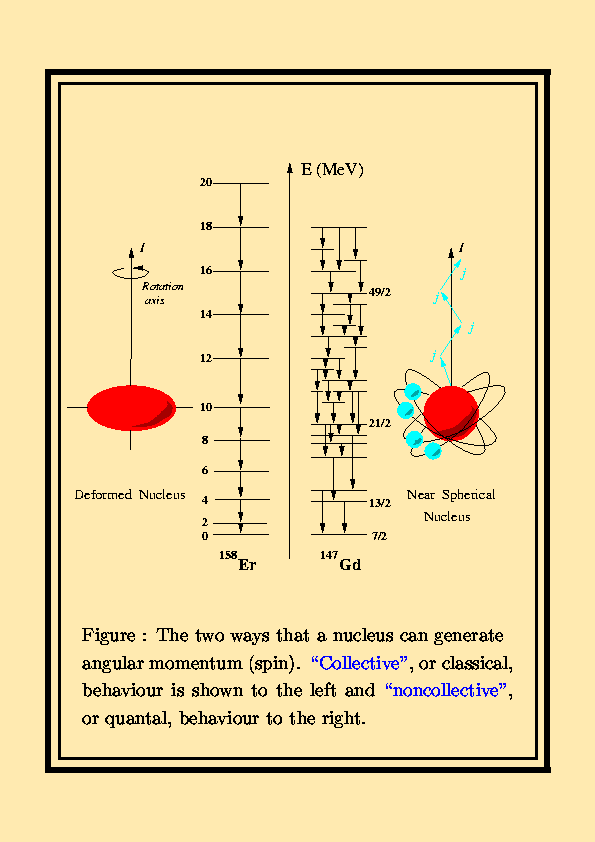
Nuclei with proton and neutron numbers near shell closures are particularly rich in nuclear structure. The small yet finite number of valence particles (holes) is able to break the spherical symmetry and induce, albeit small, nuclear deformation. Because the small (prolate) deformation requires high angular velocity to generate collective angular momentum, specific noncollective "aligned" oblate states, where the nuclear spin is made up completely from single-particle angular momentum contributions, are able to compete energetically with the weakly deformed collective structures.
In the region of the nuclear chart just above the Z=50 shell closure near N=64, energetically favoured (yrast) oblate states were originally predicted at spins around I=35 in the light barium (Z=56) isotopes, however to date no experimental evidence has been found for such states. Subsequently, calculations based on a deformed Woods Saxon single-particle potential indicated similar oblate states at I=20-30 in xenon (Z=54) isotopes. Indeed, evidence for such noncollective oblate states has been presented for several Xe isotopes near A=120. Furthermore, similar yrast oblate states at I=39/2- and 43/2- have been found in the series of odd-A iodine (Z=53) isotopes ranging from 115I up to 121I. Recent investigations of tellurium (Z=52) isotopes have also identified unusually low-lying 39/2- states in the odd-A isotopes, and 16+ states in the even isotopes, which have again been interpreted in terms of yrast noncollective oblate configurations where the total nuclear spin is generated from single-particle contributions [Ref]. A level scheme for 121I [Ref] is shown in the figure below, where it can be seen that the collective rotational behaviour (regular band structure: red) at low spin is replaced by a complex single-particle structure (blue) at high spin. Note the particularly low-lying states at 39/2- and 55/2- which represent energetically favoured noncollective oblate states.
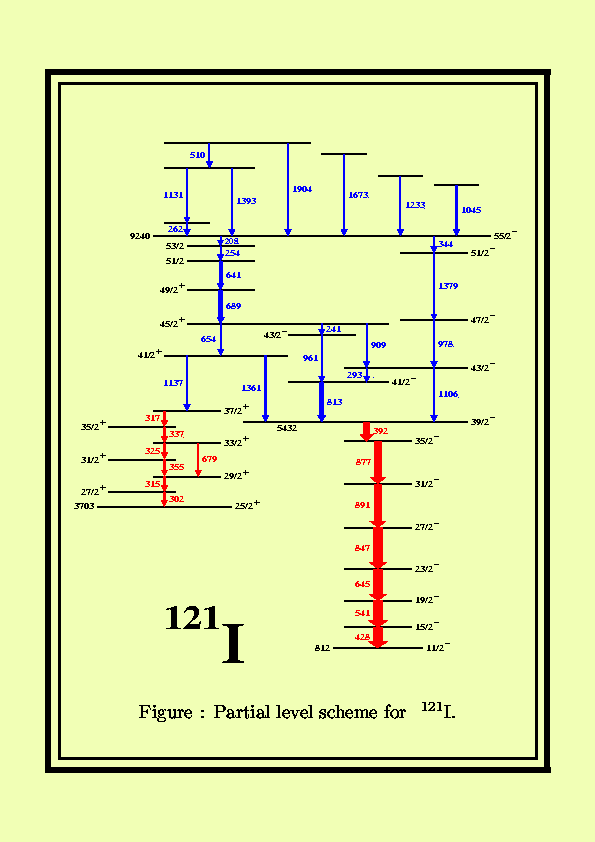
A novel type of band termination has been observed for high-spin intruder rotational bands in Z=49-54 nuclei, e.g. [Ref]. These bands are yrast over many transitions (I=20-50) until they ultimately terminate with expensive energy costs for the final states before termination. The bands involve particle-hole proton excitations (1p-1h, 2p-2h, etc.) across the Z=50 shell gap via the proton g7/2-g9/2 level crossing at prolate deformations, which appears to stabilise deformed core configurations at low spin. At higher spin as additional particle alignment takes place, most of these intruder bands display the unique characteristic of gradually decreasing dynamic moments of inertia to unusually low values, less than a third of the rigid-body value. This structure feature, so-called "smooth band termination", has been interpreted with calculations by I. Ragnarsson et al., who showed that as the available valence nucleons outside of the Z=N=50 double shell closure align, the nuclear shape gradually traces a path through the triaxial gamma plane from a collective prolate shape (0o) to the noncollective oblate shape (60o) over many transitions. After the available valence particles for a specific yrast configuration have aligned, the band sequence terminates at a spin that exhausts the sum of the aligned single-particle spins. The final energetically "unfavoured" terminating states reside well above yrast. This behaviour is illustrated in the figure below for three terminating bands in the nucleus 109Sb, which are compared to theory [Ref].
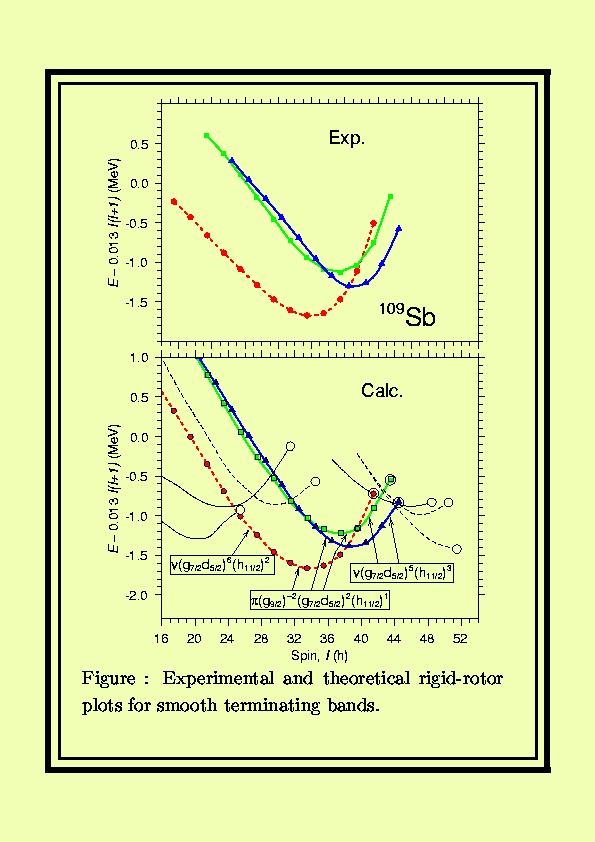
A recent experiment (GS89) combining GAMMASPHERE with the MICROBALL charged-particle array and also neutron detectors has shown up more examples of smooth terminating bands in the very neutron-deficient Te isotopes.
Recent work on odd-N xenon isotopes, both from data collected with EUROGAM II (Strasbourg) and JUROSPHERE (Jyväskylä), has uncovered further terminating bands in 117I [Ref], 117Xe [Ref], and 119Xe [Ref], respectively. The xenon isotopes are interesting since they already contain four protons outside the Z=50 core and may not need the particle-hole excitations to induce the smooth terminating bands. The configurations with ("core excited") and without ("valence space") the particle-hole excitations are predicted to possess different quadrupole deformations. Lifetime measurements using the Doppler Shift Attenuation Method (DSAM) are sensitive to the nuclear deformation and should be able to distinguish between the possible core-excited and valence-space configurations. The calculated shape trajectories are shown below for theoretical valence-space (labelled [02,5]) and core-excited (labelled [22,5]) configurations. It is interesting that the core-excited configurations are similar to the superdeformed bands seen in the cerium isotopes of the mass 130 region, which also contain two holes in the Z=50 core.
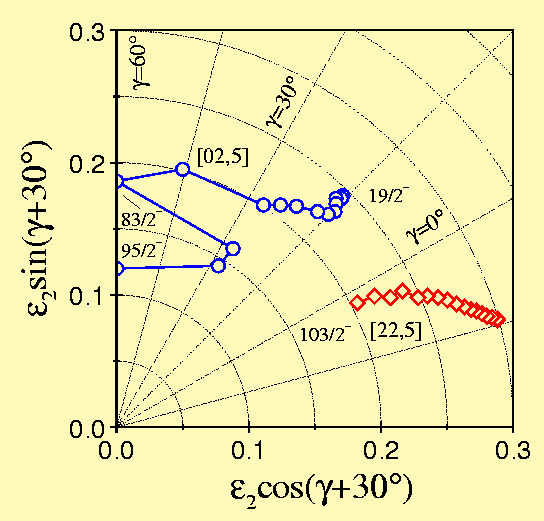
A DSAM experiment has recently taken place at Stony Brook. Experimental transition quadrupole moments, obtained through a Doppler broadened lineshape (DBLS) analysis, are shown below for 119Xe and compared to theory.
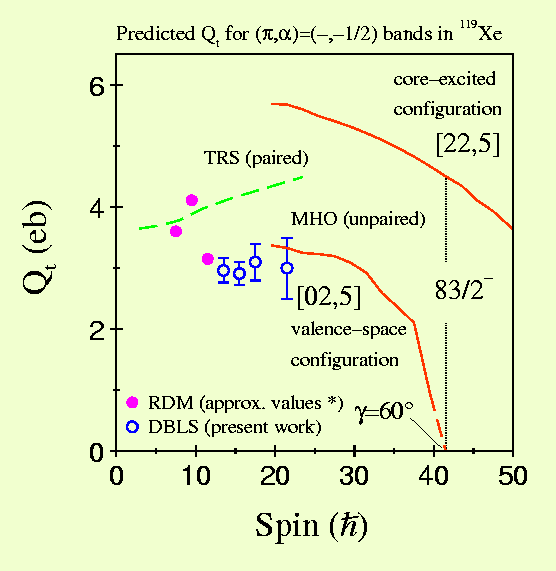
The results favour the valence-space configuration, as do similar lineshape results for a negative-parity band in 114Xe [Ref], which has recently been studied at Jyväskylä. Smoothly terminating bands based on valence-space configurations have also been established in the very light 113Xe [Ref] and 111I [Ref] nuclei. However, recent results from GAMMASPHERE with the MICROBALL (GSFMA92) have found evidence for a positive-parity, core-excited terminating band in 114Xe [Ref]. A rigid-rotor plot is shown below compared to theory, where it can be seen that `band 3' corresponds to the [22,4] configuration.
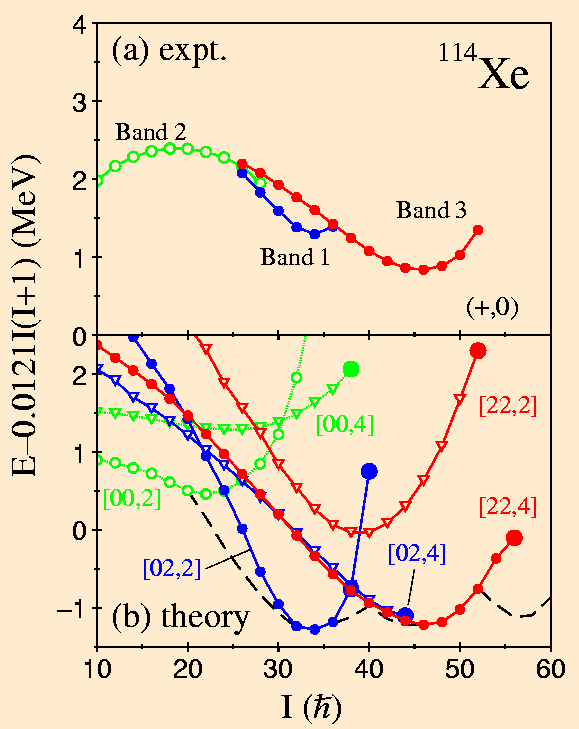
Neutron-deficient
isotopes around Z=54 are predicted to show
a softness with respect to octupole deformation at low spin.
The signature for such effects are interleaved positive and
negative parity bands connected by enhanced E1 transitions
(I=5-15![]() ).
This is due to both proton and neutron levels, arising from
the same h11/2 and d5/2
orbitals
(
).
This is due to both proton and neutron levels, arising from
the same h11/2 and d5/2
orbitals
(![]() j=
j=![]() l=3)
being near the Fermi surface.
In 109,110,112Te, strong dipole transitions have been
observed linking interleaved bands at higher spin
(I=16-22
l=3)
being near the Fermi surface.
In 109,110,112Te, strong dipole transitions have been
observed linking interleaved bands at higher spin
(I=16-22![]() )
[Ref].
Angular correlation measurements of these transitions are consistent
with pure stretched dipole transitions and they have been interpreted as
E1 transitions connecting positive-parity and negative-parity bands.
This situation suggests octupole effects in these nuclei at high spin.
More recently, enhanced E1 transitions have been observed in other
tellurium and xenon isotopes as shown below.
)
[Ref].
Angular correlation measurements of these transitions are consistent
with pure stretched dipole transitions and they have been interpreted as
E1 transitions connecting positive-parity and negative-parity bands.
This situation suggests octupole effects in these nuclei at high spin.
More recently, enhanced E1 transitions have been observed in other
tellurium and xenon isotopes as shown below.
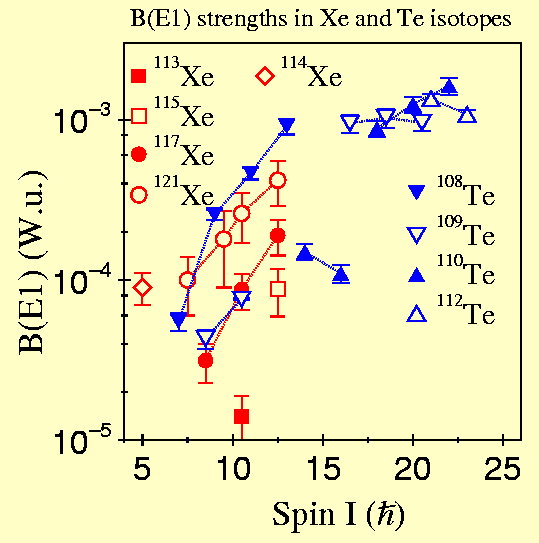
The odd-N xenon isotopes all show an (exponentially) increasing trend in B(E1) strength with spin. There is a factor of five difference in strength between spin 15/2 and 25/2. There is also a general trend of increasing B(E1) strength with mass number for the odd-N xenon isotopes. An exception to this observation, however, is the lack of any E1 strength in 119Xe although the level scheme has been recently expanded considerably [Ref]. The strongest E1 strengths are observed for the near-spherical tellurium isotopes, albeit at higher spin, which appear to saturate at B(E1)=10-3 W.u. for 109,110,112Te. These latter values are similar to those found in neutron-rich barium (Z=56) nuclei and are slightly smaller than values typical of the Ra-Th region.
This work has been carried out mainly in collaboration with groups from York (UK), Daresbury (UK), Stony Brook (USA), Chalk River (Canada), Grenoble (France), and Debrecen (Hungary).
Document Last Modified
Maintained by Eddie Paul <esp@ns.ph.liv.ac.uk>